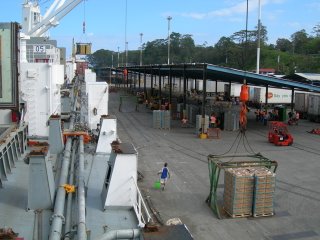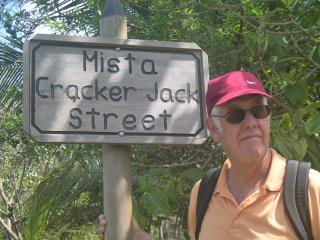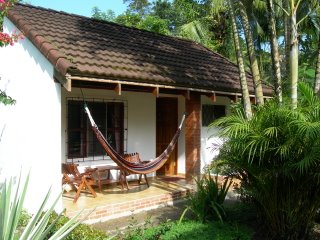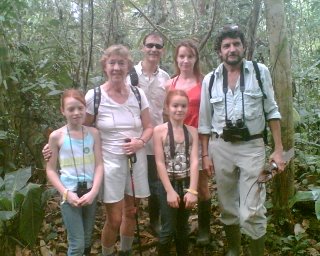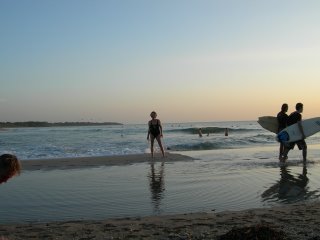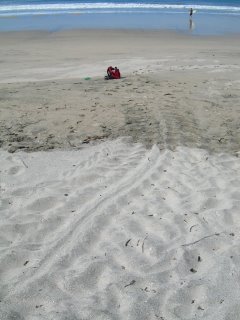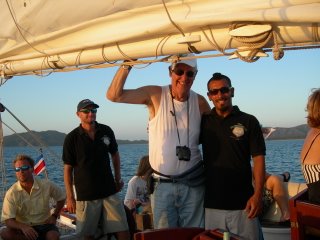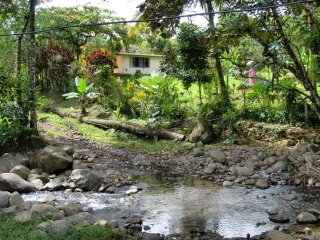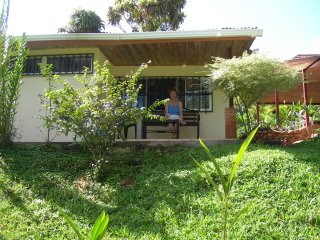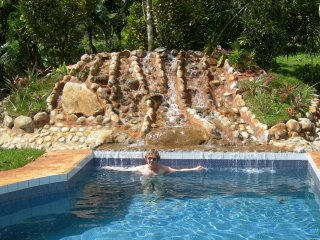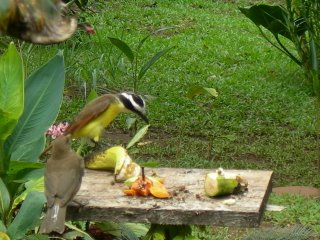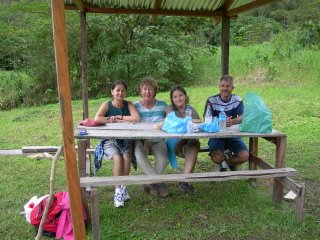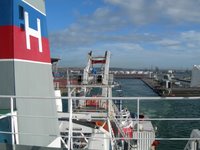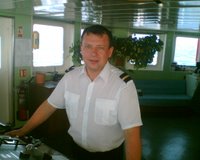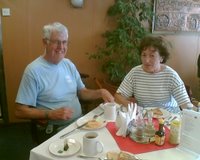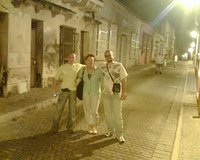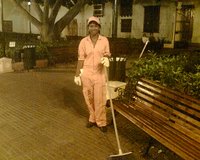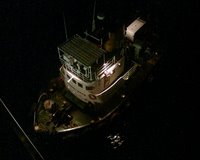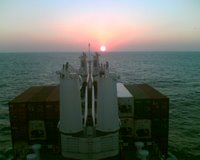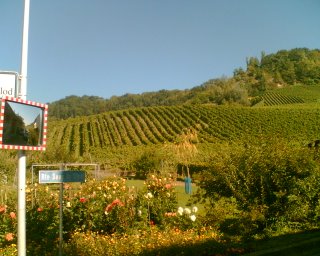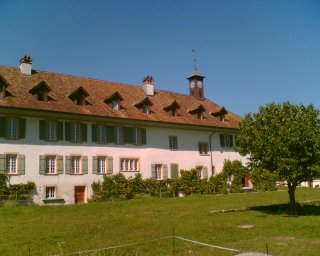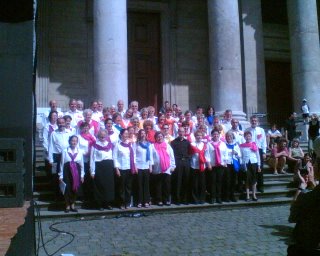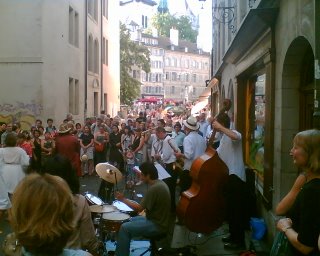.gif)
Contents:
Facts
Assorted curious facts
Development
Madeira now
Being a tourist in Madeira
The sting
Conclusion
Facts
• Madeira is a volcanic rock that emerged from the Atlantic ocean long ago. The island is 57 km east to west and 22 km north to south – although it seems much larger because of its topography. It is situated about 360 miles west of the coast of Africa, slightly south of Casablanca and north of the Canary Islands.
• Madeira is an autonomous region of Portugal and is consequently a part of the European Union. So are the Azores which lie to the northwest of Madeira, really far out in the Atlantic.
 • When is the island was first colonized, it was heavily wooded – Madeira means “wood”. To gain land for cultivation, the forest was set on fire; it is said to have burned for seven years. The main natural disaster is not volcanic eruption but rather mudslides.
• When is the island was first colonized, it was heavily wooded – Madeira means “wood”. To gain land for cultivation, the forest was set on fire; it is said to have burned for seven years. The main natural disaster is not volcanic eruption but rather mudslides.
• The name of the capital Funchal derives from the word fennel (“funcho” in Portuguese) which grew there as large trees – and not the plant we recognise as fennel.

• It is almost impossible not to have a brilliant view of the sea. There are hills and gorges and steep roads everywhere.
• The island enjoys a constant, moderate climate - although every village and surrounding area has its own micro climate. According to altitude and the prevailing winds, bananas and other fruits, sugar cane, vines, maize, etc. flourish. And Madeira is famous for its abundance of flowering trees and bushes. Almost every crop grows and thrives if sown in the right place.
• Income from tourism is a major source of gross national income.
• Unfavourable currents make sea passage from Africa difficult or impossible - added to which Madeira has practically no beaches. As a result African migrants/boat people in search of a better life do not reach the island.

• Since the island is rugged stretching from sea level to 1800+ m at its highest points, terraces for cultivation were built on the sides of the mountains. An ingenious system of water channels, “levadas” ensures irrigation of the crops.

Walking along the levadas is a major tourist attraction – as long as you have a head for heights since there are sheer drops in many places (no photos of the scary parts!)
Assorted Curious Facts
• Bananas are too short for export to the EU, so only mainland Portugal gets to eat them.
• Dairy products come from the Azores - the islands have more level ground for cattle grazing; meat is mostly imported from Brazil and Argentina. Pork is a delicacy eaten at Christmas, yes, they do have pigs who usually live on the ground floor of farmhouses.
• Despite the humid winters, Madeira’s climate was long considered beneficial for tuberculosis patients as testified by sanatoriums dotted around the mountainside above Funchal.
• Swimming pools: if less than 1.5 m depth, no lifeguard is needed. At the Savoy Hotel pool depth is 1.46 m.
• English is widely spoken, except oddly enough by taxi drivers who are not overly friendly. Watch the taxi meters and try not to get taken for a roundabout ride…
• The runway of the airport near Funchal is built into the side of a mountain; it was recently extended to 2.7km. This extension is supported by pillars sunk into the seabed – and is supposedly avoided by landing aircraft whenever possible. It does look amazing!
• Madeira’s New Year’s fireworks are world famous – although I had never heard that before.
Development
Until the 1960s, the island was poor and unable to support its high population density. It rained heavily for several months of the year which caused extensive flooding (climate change has fixed that!). The road infrastructure was minimal; footpaths connected villages, and it took seven days to reach the western tip of the island from the capital Funchal. The isolation of the villages resulted in inter marriage among close family members and ensuing genetic disorders.
Following WWII, with population density and increasingly divided shareholdings, emigration increased. Top destinations were Venezuela, Brazil and South Africa. Family estates and farms were abandoned and previously cultivated areas lay fallow. Many Madeirans returned with the island's increasing prosperity beginning in the 1980s. They are building imposing houses on their properties.
Beginning in the 1960s, rapid advances were made in infrastructure: construction of roads, provision of electricity, and much improved communication. The island now has a telecommunications structure that should be the envy of the “developed world”, including Geneva. Every town and village has a public area, usually a park or central square, with a sign indicating “WiFi Zone”. Yes, it does work.
Bus transport is plentiful to all parts of the island radiating from Funchal – so it is the best base if one does not rent a car.
Unlike Portugal which has centralized health and educational services, Madeira is decentralizing such services to villages and regional centres. Out-of-work health professionals and educators from mainland Portugal are finding employment on the island.
Being a tourist in Madeira
Accommodation ranges from the most luxurious to basic (I believe). A large collection of hotels is grouped in the Lido area above the sea within easy reach of Funchal.

Restaurants in tourist areas serve boring “international cuisine” and prices are much higher than in local neighbourhoods. So eating “local” is a tastier and less expensive option.
Delicacies include “Espetada”, meat on laurel skewers which are suspended from an iron device above your table; “bolo do caco”, bread cooked on heated stone and prepared with garlic butter. Fish is plentiful ranging from tuna and cod to the rather special – and very ugly – scabbard.

The Atlantic is very deep around the island and the scabbard lives on the seabed, except during a certain time of the night when it comes nearer the surface to feed. Line fishing is compulsory in Madeira; hundreds of lines are cast, the scabbards bite, are pulled up quickly – and die from decompression sickness!

Museums and culture emphasise the island’s Catholic tradition. I cannot say much about museums, since they were mostly closed for renovation or whatever when we tried to visit. One exception was the Electricity Museum that appropriately depicted the gradual electrification of the island.
The cultural offering is impressive. In 12 days we attended four classical concerts ranging from a mandolin concert (so many different types of mandolin) to the conservatory’s presentation of its classes devoted to specific instruments and voice, to chamber music, and to an international quality symphony evening.
The Sting
It is not called “Time Share” any more but rather “Vacation Clubs”. Many hotels have rooms or apartment reserved for people who have bought into this concept.
We were upgraded to a “junior suite” on check-in at our first hotel, very nice it was too, but then downgraded after six nights, since the “owners” were arriving. We attended a cocktail given at our hotel for its time sharers and asked people if they were happy with their arrangement. Without exception the reply was that at the outset it was fine, but that as time passed (and people sign up for 15-20 years) the additional charges and difficulty in exchanging for other destinations became problematic.
Vacation Club member/ownership is peddled in the street and in tour agencies, often by native English speakers. Sales people represent big hotels, existing or planned. So walking down the street we were repeatedly accosted by such representatives who wanted us to take a tour of their hotel and hear a sales talk – of no more than 90 min. – in exchange for which we were offered half price admission to the Casino floor show, bottles of wine or other goodies.
Did we fall for it? Yes, sort of, we willingly walked into a tour agency that was offering deep discount island tours – against 90 min. of our time, it turned out, to hear about this great vacation club plan at a brand new hotel beautifully situated on the rocky beach in Funchal.

What followed was a very targeted sales pitch. Every couple had their own presenter speaking their language. It was decided that we were Dutch, so we got Flemish Bernard who started out in – well Dutch/Flemish, until we agreed that he should continue in French. We said that we had maximum 90 min; Bernard said that it would be difficult to extol the wonders of the plan in such a short time, but we held him to it. I will not bore you with the details, except to say that the two-year trial plan was a great deal that included seven nights at the Royal Savoy, as well as various other advantages, at a cost which was less than we were paying at our very nice hotel. Since we were looking for a week’s accommodation starting two days hence, we said ok. We saw some rooms and the facilities, Bernard was to check availability and we agreed to return that afternoon – to sign the trial membership and pay. And Bernard insisted on taking us to the airport for our return flight at the end of our stay!
We turned up that same afternoon and there was Bernard wringing his hands and looking very troubled. The hotel was fully booked due to a golf tournament (it was actually held the following week); he had pleaded with the owner (see below) to find a studio for us, etc. He was very sorry – and then produced a card of his personal travel business offering us a week at this same hotel – at another time and at half price. So much for ethical business practices.
Reflecting on this failed transaction, I concluded that 1) it was too sweet a deal for us as customers and 2) the objective of having people sign up to the scheme is to have return visitors as well as being able to sell them the extras, such as travel arrangements, car hire, “concierge d’or” (whatever that is) etc.
Incidentally, the owner of the Savoy Hotel and its brand new sister, the Royal Savoy, is a certain José Manuel Rodrigues Berardo, a Madeira born businessman, speculator and art collector, and one of Portugal’s 10 richest men. The art dotted about the hotel was beautiful! And the venerable original Hotel Savoy is being pulled down in a couple of years – to make room for an even more splendid hotel.
Conclusion
We were amused more than anything – and relieved not to have signed or paid anything. We found accommodation in a wonderful aparthotel in Funchal at a most reasonable price, I’ll be happy to pass on the details. Our “reward” for attending the sales talk, the all-day minibus tour, was great and included morning coffee and a 3-course lunch with wine, all for 25 euros for the two of us. We later took a similar tour to another part of the island – at the full price of 80 euros for two – and it was still a very good deal.

Many "touristy" things are not covered above. Maybe I should mention the wood sledges or toboggans - a curious mode of transportation originally pulled by bullocks on typical Maderia pavement and used to transport goods and - in a more comfortable version - to transport well-to-do residents from upper Funchal down to the waterfront. A couple of strong men are needed to run alongside and keep the sledges from speeding out of control down the steep roads. Now rides are offered to tourists - at considerable cost.
Madeira is a popular destination for individual visitors from many European countries, particularly Britain. We noticed very few groups and hardly any vacationers from North America. Funchal is also a busy cruise port. Most days see huge liners moor to regurgitate hundreds of passengers for a few hours.
(Disclaimer: Much of the information above has been obtained from informal sources; if you find inaccuracies I will be happy to stand corrected.)




